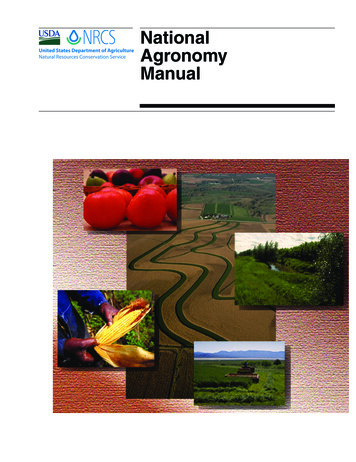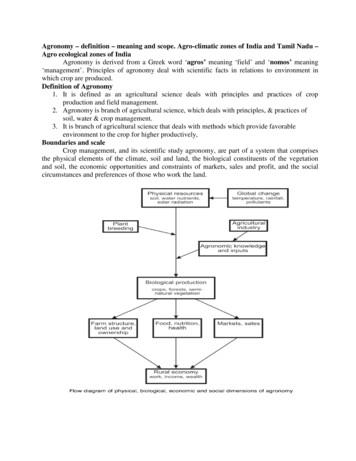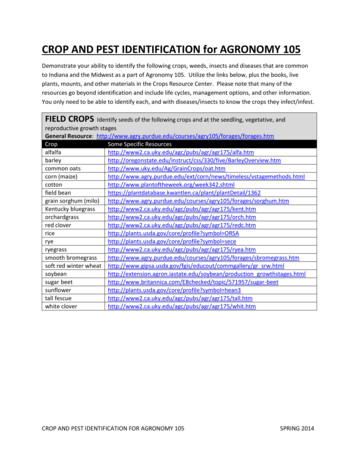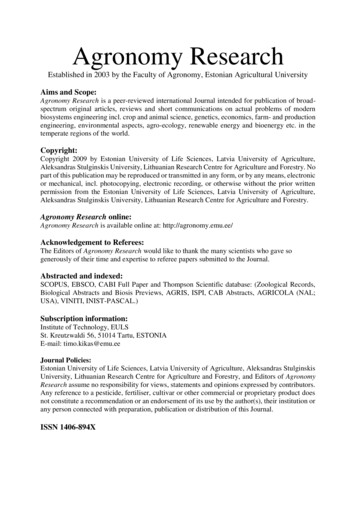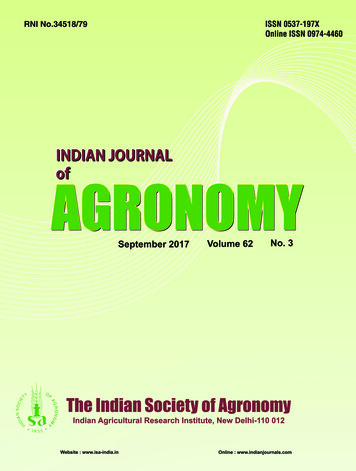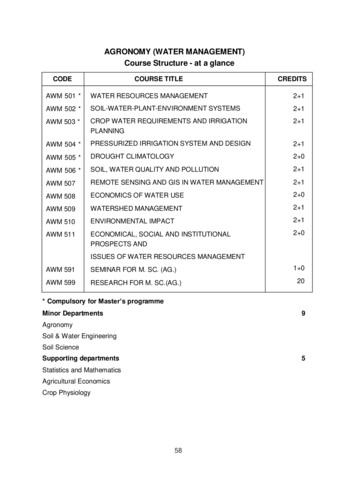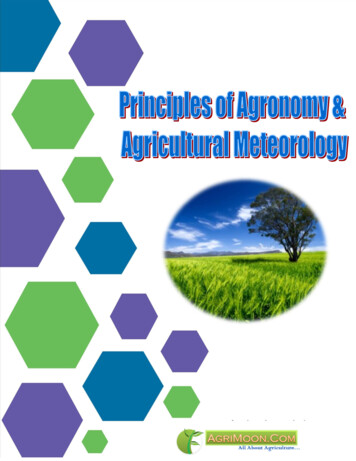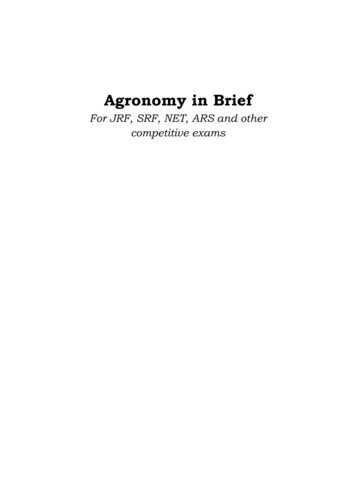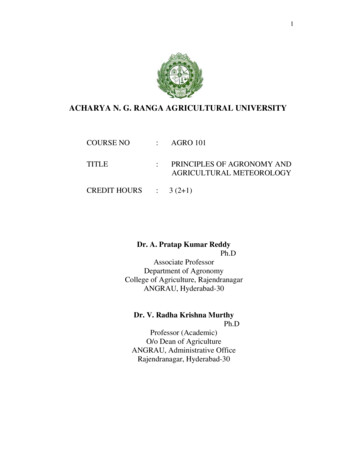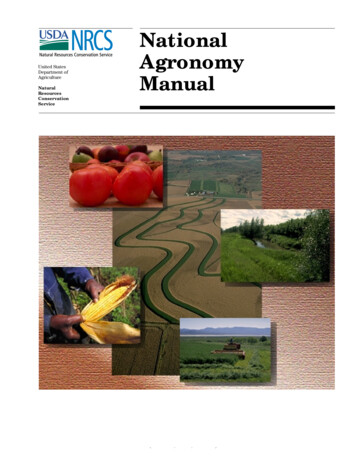
Transcription
United StatesDepartment tionalAgronomyManual(190-V-NAM, 3rd Ed., June 2000)i
NationalAgronomyManualJune 2002The United States Department of Agriculture (USDA) prohibitsdiscrimination in all its programs and activities on the basis of race, color,national origin, gender, religion, age, disability, political beliefs, sexualorientation, and marital or familial status. (Not all prohibited bases apply toall programs.) Persons with disabilities who require alternate means forcommunication of program information (Braille, large print, audiotape,etc.) should contact the USDA’s TARGET Center at (202) 720-2600 (voiceand TDD).To file a complaint of discrimination, write USDA, Director, Office of CivilRights, Room 326W, Whitten Building, 14th and Independence Avenue, SW,Washington, DC 20250-9410, or call (202) 720-5964 (voice or TDD). USDA isan equal opportunity employer.ii(190-V-NAM, 3rd Ed., June 2002)
NationalAgronomyManualContents:Part 500Authorities, Policies, and ResponsibilitiesPart 501Water ErosionPart 502Wind ErosionPart 503Crop ProductionPart 504Water ManagementPart 505Air QualityPart 506Plant AttributesPart 507Cropland Conservation Management SystemsPart 508SoilsPart 509Data ManagementGlossary(190-V-NAM, 3rd Ed., June 2002)
Part 500Contents:Subpart 500AAuthorities, Policies, l Conservation and Domestic Allotment Act of 1935 . 500–1Purpose of the Agronomy Manual . 500–1Subpart 500BAgronomic policies500–2500.10 Location of policy . 500–2500.11 Amendments to NAM . 500–2Subpart 500CResponsibilities of agronomists500–2500.20 Responsibilities of national, State, area, and field agronomists . 500–2500.30500.40500.50Technical information—preparing, transferring, and training . 500–3Certification . 500–3Affiliation with professional organizations . 500–3(190-V-NAM, 3rd Ed., June 2002)500–i
500–ii(190-V-NAM, 3rd Ed., June 2002)
(190-V-NAM, 3rd Ed., June 2002)
Part 500Authorities, Policies, andResponsibilitiesSubpart 500A Authority500.01 Purpose of the AgronomyManual500.00 Soil Conservation andDomestic Allotment Actof 1935The National Agronomy Manual (NAM) containspolicy for agronomy activities and provides technicalprocedures for uniform implementation of agronomytools and applications.The basic legislation for soil and water conservationprograms by the Natural Resources Conservation Service (NRCS) is the Soil Conservation and Domestic Allotment Act, Public Law 74–46 of 1935 (16 U.S.C. 590a590f). This original act recognized that agronomy, thescience of field crop production, is essential in fulfilling the agency’s responsibilities. The BuchananAmendment to the Agricultural Appropriations Bill forFY 1930 (Public Law 70-769) led to the enactment ofPublic Law 74-46. In 1933, the Soil Erosion Service wasestablished as a temporary agency of the Departmentof the Interior. The agency was transferred to USDA in1935 and named the Soil Conservation Service (SCS).In 1994, the Natural Resources Conservation Servicewas established by Public Law 103–354, the Department of Agriculture Reorganization Act (7 U.S.C. 6962).The NRCS combines the authorities of the former SoilConservation Service as well as five natural resourceconservation cost-share programs previously administered by other USDA agencies. The mission of theNRCS is to provide leadership in a partnership effort tohelp people conserve, maintain and improve our natural resources and environment. NRCS provides technical assistance through local conservation districts on avoluntary basis to land users, communities, watershedgroups, Federal and State agencies, and other cooperators. The agency’s work focuses on erosion reduction,water quality improvement, wetland restoration andprotection, fish and wildlife habitat improvement,range management, stream restoration, water management, and other natural resource problems.190-V-NAM, 3rd Ed., June 2002)500–1
Part 500Authorities, Policies, andResponsibilitiesSubpart 500B Agronomicpolicies500.10 Location of policyAgronomic policies are contained in specific parts andsubparts of this National Agronomy Manual as appropriate.500.11 Amendments to NAMThe NAM will be amended as needed, as additional research is completed, existing methods or proceduresare updated, or as new technology is developed andapproved for use in the NRCS. The national agronomist is responsible for updating this manual.NationalAgronomyManualSubpart 500C Responsibilities of agronomists500.20 Responsibilities ofnational, State, area,and field agronomistsThe national agronomist, nutrient management, andpest management specialists at the national level, cooperating scientists for agronomy, and agronomists onthe institutes and center staffs provide staff assistancein all NRCS programs and provide national leadershipon NRCS agronomy related activities. They are responsible for: assisting upper management in formulating andrecommending national policies, procedures, andstandards; technical leadership and guidance; qualitycontrol; national coordination of agronomy with otherNRCS technical fields; and promoting and maintaining relations with groupsand agencies that have common interest inagronomy.State agronomists provide staff assistance to the StateConservationist for all agronomy and related functions. They are responsible for: Assisting in developing State policies, procedures, and instructions, and coordinating themwith other States within the region. Providing technical leadership and guidance toother agronomists and appropriate personnelwithin the State. Collaborating with other State staff members toensure interdisciplinary action in all NRCS programs. Training field personnel. Participating in agronomy components of appraisals and reviews. Maintaining working relations with researchcenters and other cooperating agencies. Developing and revising of all aspects of FieldOffice Technical Guides related to agronomy.500–2(190-V-NAM, 3rd Ed., June 2002)
Part 500Authorities, Policies, andResponsibilities Providing assistance in interdisciplinary technical reviews of project plans, environmentalimpact statements, and other technical materials. Coordinating agronomy functions with otherStates in the region and across regional boundaries as appropriate.Area or zone agronomists provide staff assistance inall NRCS programs. They are responsible for carryingout the requirements of conservation agronomy consistent with technical proficiency, training, interdisciplinary action, and quality control within their administrative area. In some cases, these agronomists maycarry out some of the responsibilities of the stateagronomists if so delegated.Field office agronomists are usually in training positions. Training is provided by agronomists at the areaor State level.Agronomists in the above positions may provide specific functions through team or ad hoc assignments ata national, regional, or State level.Each agronomist has the responsibility to developtheir training needs inventory and to work with theirsupervisor to obtain technical training to improve theiroverall agronomic expertise.Standards of performance for agronomists are contained in the NRCS Personnel Manual.500.30 Technical information—preparing, transferring,and trainingAgronomists use technical information that has beendeveloped at centers, institutes, national, or State leveland maintain technical materials for the administrativearea they serve. State staff agronomists develop andreview field office technical guide materials and ensure materials are technically correct, comprehensive,and useful to the end user. NRCS policy on preparingand maintaining technical guides is in Title 450-GM,Part 401. In addition, state agronomists are responsible for technical notes and other agronomy technicalmaterials that are applicable to the State.NationalAgronomyManualAgronomists issue technical information at the area,state, or national level. This may include original information, research notes, papers, or excerpts of suchmaterial. Agronomists are encouraged to submit articles for publication or presentation at professionalmeetings. Technical information presented or prepared for publication shall have an appropriate technical and or administrative review and include creditingof appropriate references.Agronomists receive and provide training necessary tomaintain technical competency at all administrativelevels. Training includes but is not limited to NationalEmployee Development Courses, workshops, conferences, and university courses.500.40 CertificationAgronomists at all levels of the agency are encouragedto obtain professional certification(s). Examples ofcertification programs include the Certified Crop Adviser (CCA) and Certified Professional Agronomists(CPAg) under ARCPACS of the American Society ofAgronomy, Certified Professional in Erosion and Sediment Control (CPESC) of the Soil and Water Conservation Society, and state pesticide applicator licenses.Continuing educational requirements of most certification programs provide excellent opportunities to stayabreast of advances in technology.500.50 Affiliation with professional organizationsAgronomists at all levels are encouraged to be activemembers of professional scientific societies, such asthe American Society of Agronomy, Soil Science Society of America, Crop Science Society of America, theSoil and Water Conservation Society. These organizations provide opportunities to interact with researchers at the national and State level and to stay currenton the latest technology.(190-V-NAM, 3rd Ed., June 2002)500–3
Part 501Contents:Water ErosionSubpart 501AIntroduction501–1501.00 Overview of Content in Part 501 Water Erosion . 501–1Subpart 501BWater erosion501.10501.11Subpart 501CSubpart 501DSubpart 501E501–1Forms of water erosion . 501–1The water erosion process . 501–1Estimating sheet and rill erosion501–2501.20 How, why, and by whom water erosion is estimated . 501–2501.21501.22501.23Methods of estimating sheet and rill erosion . 501–2The Revised Universal Soil Loss Equation . 501–3Limitations of the equation . 501–3501.24501.25501.26Alternative methods of applying RUSLE . 501–3Data needed to support RUSLE . 501–3Tools for using RUSLE . 501–4RUSLE factors501–5501.30 The average annual soil loss estimate, A . 501–5501.31501.32501.33The rainfall and runoff erosivity factor, R . 501–5The soil erodibility factor, K . 501–5The slope length and steepness factors, L and S . 501–5501.34501.35The cover-management factor, C . 501–6The support practice factor, P . 501–6Principles of water erosion control501–7501.40 Overview of principles . 501–7501.41Relation of control to RUSLE factors . 501–7Subpart 501FReferences501–8Subpart 501GExhibit 501-1501–9(190-V-NAM, 3rd Ed., June 2002)501–i
Part 501Subpart 501AWater ErosionIntroductionSubpart 501BWater erosion501.10 Forms of water erosion501.00 Overview of content inPart 501 Water ErosionPart 501 presents Natural Resources Conservation Service (NRCS) policy and procedures for estimating soilerosion by water. It explains the types, the methodused to estimate, and the control of soil erosion by water. NRCS technical guidance related to water erosionshall conform to policy and procedures set forth inthis part.The Agricultural Research Service (ARS) has primaryresponsibility for erosion prediction research withinthe U.S. Department of Agriculture (USDA). ARS is thelead agency for developing erosion prediction technology, including the Revised Universal Soil Loss Equation (RUSLE). The technology in RUSLE is documented to the publication Predicting Soil Erosion byWater: A Guide to Conservation Planning With RevisedUniversal Soil Loss Equation, U.S. Department of Agriculture Handbook 703, hereafter referred to as Agriculture Handbook 703.Forms of soil erosion by water include sheet and rill,ephemeral gully, classical gully, and streambank. Eachsucceeding type is associated with the progressiveconcentration of runoff water into channels as it movesdownslope. Sheet erosion, sometimes referred to asinterrill erosion, is the detachment of soil particles byraindrop impact and the removal of thin layers of soilfrom the land surface by the action of rainfall and runoff. Rill erosion is the formation of small, generallyparallel channels formed by runoff water. Rills usuallydo not re-occur in the same place. Ephemeral gulliesare concentrated flow channels formed when rills converge to form shallow channels. They are alternatelyfilled with soil by tillage operations and re-formed inthe same general location by subsequent runoff events.Classical gullies are also concentrated flow channelsformed when rills converge. These are well defined,permanent incised drainageways that cannot becrossed by ordinary farming operations.Other forms of erosion that are related to soil erosionby water include stream channel and geologic. Streamchannel erosion refers to the degradation of channelsand waterways. Geologic erosion refers to long-termerosion effects, as opposed to accelerated erosionevents discussed in the Subpart.No reliable methods exist for predicting the rate ofephemeral gully, classical gully, stream channel, orgeologic erosion. The remainder of this part deals onlywith prediction and control of sheet and rill erosion.501.11 The water erosion processThe processes of sheet and rill erosion are detachment, transport, and deposition of soil particlescaused by raindrop impact and surface runoff.Detachment is the removal of particles from the soilmass and is expressed in units, such as tons per acre.When soil particles are removed from the mass, theyare referred to as sediment.190-V-NAM, 3rd Ed., June 2002)501–1
Part 501NationalAgronomyManualWater ErosionThe movement of sediment downslope is sedimenttransport. A measure of sediment transport is sediment load. Sediment load on a slope increases withdistance downslope as long as detachment is occurring. That is, detachment adds to the sediment load.Where runoff is slowed at the base of a slope or bydense vegetation, deposition occurs, which is thetransfer of sediment from the sediment load to the soilmass. That is, deposition removes sediment from thesediment load, and accumulates on the soil surface.Two types of deposition, remote and local, occur. Remote deposition occurs some distance away from theorigin of the sediment. Deposition at the toe of a concave slope, on the uphill side of vegetative strips, andin terrace channels are examples of remote deposition.Local deposition is where sediment is deposited near,within several inches, of where it is detached. Deposition in microdepressions and in low gradient furrowsare examples of local deposition.Subpart 501C Estimatingsheet and rill erosion501.20 How, why, and by whomwater erosion is estimatedNRCS estimates soil erosion by water as part of itstechnical assistance to land users. In conservationplanning, erosion estimates are made for an existingmanagement system and compared with alternativesystems and with soil loss tolerance, T, values.In addition, soil loss estimates are used to inventorynatural resources, evaluate the effectiveness of conservation programs and land treatment, and estimatesediment production from fields that might becomesediment yield in watersheds.In March 1995, NRCS adopted RUSLE as the officialtool for predicting soil erosion by water. NRCS continues to use USLE for certain provisions of Farm Billprograms and for the NRCS National Resources Inventory (NRI).501.21 Methods of estimatingsheet and rill erosionEfforts to predict soil erosion by water started in the1930’s. Cook (1936) identified the major variables thataffect erosion by water. Zingg (1940) published thefirst equation for calculating field soil loss. Smith andWhitt (1947) presented an erosion-estimating equationthat included most of the factors present in modernsoil loss equations. The Musgrave equation (Musgrave1947) was a soil loss equation developed for farm planning. Finally, an effort was initiated to develop a national equation from the various state and regionalequations that existed in the 1950’s. In 1954, the Agricultural Research Service established the NationalRunoff and Soil Loss Data Center at Purdue Universityin West Lafayette, Indiana, to consolidate all availableerosion data. Using the data assembled at the DataCenter, Wischmeier and Smith (1965) developed theUniversal Soil Loss Equation (USLE).501–2(190-V-NAM, 3rd Ed., June 2002)
Part 501NationalAgronomyManualWater ErosionThe USLE was a consolidation of several regional soilloss equations, and was based on summarizing and statistical analyses of more than 10,000 plot-years of basic runoff and soil loss data from 49 U.S. locations (Agriculture Handbook 703, 1997; Wischmeier and Smith1965, 1978).RUSLE predicts long-term average annual soil loss carried by runoff from specific field slopes under specified cover and management systems. It is substantially less accurate for the prediction of specific erosion events associated with single storms and shortterm random fluctuations.The USLE was designed to provide a convenient working tool for conservationists. It quantifies soil erosionas a product of six factors representing rainfall andrunoff erosiveness, soil erodibility, slope length, slopesteepness, cover-management practices, and supporting practices.RUSLE also estimates sediment yield for the amountof eroded soil leaving the end of a slope with certainsupport practices (see 501.35). It does not predictsediment yield for the amount of sediment that is delivered to a point in a watershed, such as the edge of afield, that is remote from the origin of the detachedsoil particles. Nor does RUSLE predict erosion thatoccurs in concentrated flow channels.501.22 The Revised Universal SoilLoss EquationSince March 1995, the Revised Universal Soil LossEquation (RUSLE) has been used by NRCS to estimatesoil loss by water (Agriculture Handbook 703.).RUSLE predicts long-term average annual soil lossfrom sheet and rill erosion. RUSLE is an update of theUniversal Soil Loss Equation (USLE) as described inAgriculture Handbook 537 (Wischmeier and Smith1978). RUSLE utilizes a computer program to facilitatethe calculations. RUSLE technology reflects the analysis of research data that were unavailable when Agricultural Handbook 282 (Wischmeier and Smith 1965)and Agriculture Handbook 537 were completed.501.23 Limitations of theequationThe term Universal distinguishes the USLE andRUSLE from State and regionally based models thatpreceded them. However, the use of the USLE andRUSLE is limited to situations where factors can beaccurately evaluated and to conditions for which theycan be reliably applied (Wischmeier 1978; AgricultureHandbook 703, 1997).501.24 Alternative methods of applying RUSLEARS released RUSLE in 1992 as a computer programin the DOS environment. The model calculates soilloss from a field slope using values for each factor andusing data elements from climate, plant, and field operation data bases.Since 1993, RUSLE has been implemented in manyNRCS field offices in hardcopy form in the Field OfficeTechnical Guide (FOTG). State and area agronomistshave developed tables and charts containing values foreach of the RUSLE factors. Since the RUSLE modulein Field Office Computing System (FOCS) is no longersupported by the Information Technology Center,NRCS will continue to implement RUSLE technologyusing charts and tables in the FOTG.501.25 Data needed to supportRUSLERUSLE uses soil erodibility, K, values from the NASISSoils Database. Climatic data is obtained from National Weather Service weather stations with reliablelong-term data. State and area agronomists have developed cover and management factor, C, values forcommon cropping systems.(190-V-NAM, 3rd Ed., June 2002)501–3
Part 501NationalAgronomyManualWater ErosionThe crop data base in the DOS RUSLE program contains plant growth and residue production parameters.These variables for key crops are listed in chapter 7 ofAgriculture Handbook 703. Values for many of theseparameters are available in a data base for a wide variety of plants. A user interface, the Crop Parameter Intelligent Data System (CPIDS) (Deer-Ascough et al.1995), allows the user to search the data base. TheUSDA, ARS, National Soil Erosion Research Laboratory, West Lafayette, Indiana, maintains CPIDS.Four slope length and steepness, L and S, table optionsare available in RUSLE. LS values can be obtainedfrom tables 4-1 to 4-4 in Agriculture Handbook 703.The RUSLE computer program also calculates LS factor values for both uniform and complex slopes.Development and maintenance of data bases used byNRCS in erosion prediction models are the responsibility of NRCS agronomists at the State and nationallevels. Refer to Part 509 in this Manual for more detailed information on data base management and instructions. The national agronomist maintains a database management plan that identifies the process ofdeveloping and maintaining data bases needed to support RUSLE. Data bases for some States are availablein electronic format on the Fort Worth server.Support practice factor, P, values are calculated usingtables available in the FOTG in many states. Copies,where available, can be obtained from the State office.Table values for common stripcropping and bufferstrip systems are available in the FOTG of some states.Cover and management factor, C, values are availablein electronic table format in tables in most State offices and in the Field Office Technical Guide.Hardcopy tables are available in most State offices.501.26 Tools for using RUSLEMaps of rainfall and runoff factors, R and R (see parteq501.31) for the continental United States plus Hawaiiare available in Agriculture Handbook 703, figures 2-1to 2-5 and figures 2-15 and 2-16. Additional climate-related data and inputs are available in this chapter.Most states and Basin Areas have developed countybased climatic maps for their areas. These contain thegreater detail that is desired when applying RUSLE tospecific field situations, and are available in NRCSState offices.Soil erodibility factor, K, values for RUSLE are available in the NASIS Soils Database and in other soilsdata bases and tables. In areas of the United Stateswhere K values are adjusted to account for seasonalvariability, (Agriculture Handbook 703) tables areavailable in State offices that show how the values arerounded to the nearest class and subclass.501–4(190-V-NAM, 3rd Ed., June 2002)
Part 501NationalAgronomyManualWater ErosionSubpart 501D RUSLEfactors501.30 The average annual soilloss estimate, AThe long time average annual soil loss, A, is the computed spatial average soil loss and temporal averagesoil loss per unit of area, expressed in the units for Kand for the period selected for R.As applied by NRCS, the units for K and the period forR are selected so that A is expressed in tons per acreper year. RUSLE predicts the soil loss carried by runoff from specific field slopes in specified cover andmanagement systems.501.31 The rainfall and runofferosivity factor, RThe rainfall and runoff erosivity factor, R, is the product of total storm energy times the maximum 30minute intensity. Stated another way, the average annual total of the storm energy and intensity values in agiven location is the rainfall erosion index, R, for thelocality. The R factor represents the long-term averageannual summation of the Erosivity Index (EI) for extended period of record.In dryland cropping areas of the Northwest Wheat andRange Region, the effect of melting snow, rain onsnow, and/or rain on thawing soil poses unique problems. An equivalent R value, R , is calculated for theseeqareas to account for this added runoff.501.32 The soil erodibility factor, KThe soil erodibility factor, K, is a measure of erodibility for a standard condition. This standard condition isthe unit plot, which is an erosion plot 72.6 feet (22.1 )long on a 9 percent slope, maintained in continuousfallow, tilled up and down hillperiodically to control weeds and break crusts thatform on the soil surface. The erodibility factor K represents the combined effect of susceptibility of soil to1/ Rock fragments on the soil surface are accounted for in the Cfactor.detachment, transport of sediment and the amountand rate of runoff caused by a particular rainfall event.Soil properties that affect soil erodibility include texture, structure, permeability and organic matter content. Values for K should be selected from those givenin the NRCS soil survey database in NASIS or in published reports the RUSLE soil erodibility nomographcan also be used to estimate K values for most soils.Soil erodibility K varies by season. It tends to be highin early spring during and immediately following thawing, and other periods when the soil is wet.NRCS further modifies the seasonally adjusted K byrounding the value to the nearest K factor class orhalf-class (exhibit 501-1).Rock fragments in the soil profile affect the soil erod1/ibility factor . The K value is adjusted upwards to account for rock fragments in the soil profile of sandysoils that reduce infiltration. No adjustment to the Kvalue is recommended by NRCS for rocks in the profile of medium and heavy textured soils.501.33 The slope length andsteepness factors, L and SThe slope length factor, L, is the ratio of soil loss fromthe field slope length to soil loss from a 72.6-footlength under identical conditions.The slope steepness factor, S, is the ratio of soil lossfrom the field slope gradient to soil loss from a 9 percent slope under otherwise identical conditions.In erosion prediction as used by NRCS, the factors Land S are evaluated together, and LS values for uniform slopes can be selected from tables 4-1, 4-2, 4-3,and 4-4 in Agriculture Handbook 703.The slope length is defined as the horizontal distancefrom the origin of overland flow to the location of either concentrated flow or deposition. Slope lengthsnormally do not exceed 400 feet because sheet and rillflows will almost always coalesce into concentratedflow paths within that distance. Lengths longer than1,000 feet should not be used in RUSLE.Slope length and steepness determinations are bestmade in the field. In conservation planning, thehillslope profile representing a significant portion ofthe field having the most severe erosion is often chosen. Slope lengths are best determined by pacing outflow paths and making measurements directly on theground. Steep slopes should be converted to horizon-(190-V-NAM, 3rd Ed., June 2002)501–5
Part 501tal distances. Slope steepness determinations are bestmade in the field using a clinometer, Abney level orsimilar device. Chapter 4, Agriculture Handbook 703contains additional guides for choosing and measuringslopes.Most naturally occurring hillslope profiles are irregularin shape. When the slope profile is significantly curved(convex or concave, or sigmoid.convex at the shoulderand concave at the toe), the conservationist shouldrepresent it as a series of slope segments, using the irregular slope procedure in the RUSLE computer program.501.34 The cover-managementfactor, CThe cover-management factor, C, is the ratio of soilloss from an area with specified cover and management to soil loss from an identical area in tilled continuous fallow.The C factor is used most often to compare the relative impacts of management options on conservationplans.The impacts of cover and management on soil lossesare divided into a series of subfactors in RUSLE. Theseinclude the impacts of previous vegetative cover andmanagement, canopy cover, surface roughness, and insome cases the impactof soil moisture.In RUSLE, these subfactors are assigned values, andwhen multiplied together yield a soil loss ratio (SLR).Individual SLR values are calculated for each periodover which the important parameters are assumed toremain constant. Each SLR value is then weighted bythe fraction of rainfall and runoff erosivity, EI, associated with the corresponding period, and theseweighted values are combined (summed) into an overall C factor value.501–6NationalAgronomyManualWater Erosion501.35 The support practicefactor, PThe support practice factor, P, is the ratio of soil losswith a support practice like contouring, stripcropping,or terracing to soil loss with straight-row farming upand down the slope.The contour P subfactor accounts for the beneficial effects of redirected runoff that modifies the flow pattern because of ridges or oriented roughness that arepartially or completely oriented along the contour.The contour P subfactor includes the effects of stormseverity, ridge height, off-grade contouring, sl
Agronomy Manual Authorities, Policies, and Responsibilities Part 500 500–2 (190-V-NAM, 3rd Ed., June 2002) Subpart 500B Agronomic policies 500.10 Location of policy Agronomic policies are contained in specific parts and subparts of this National Agronomy Manual as appropriate. 500.11 Am
